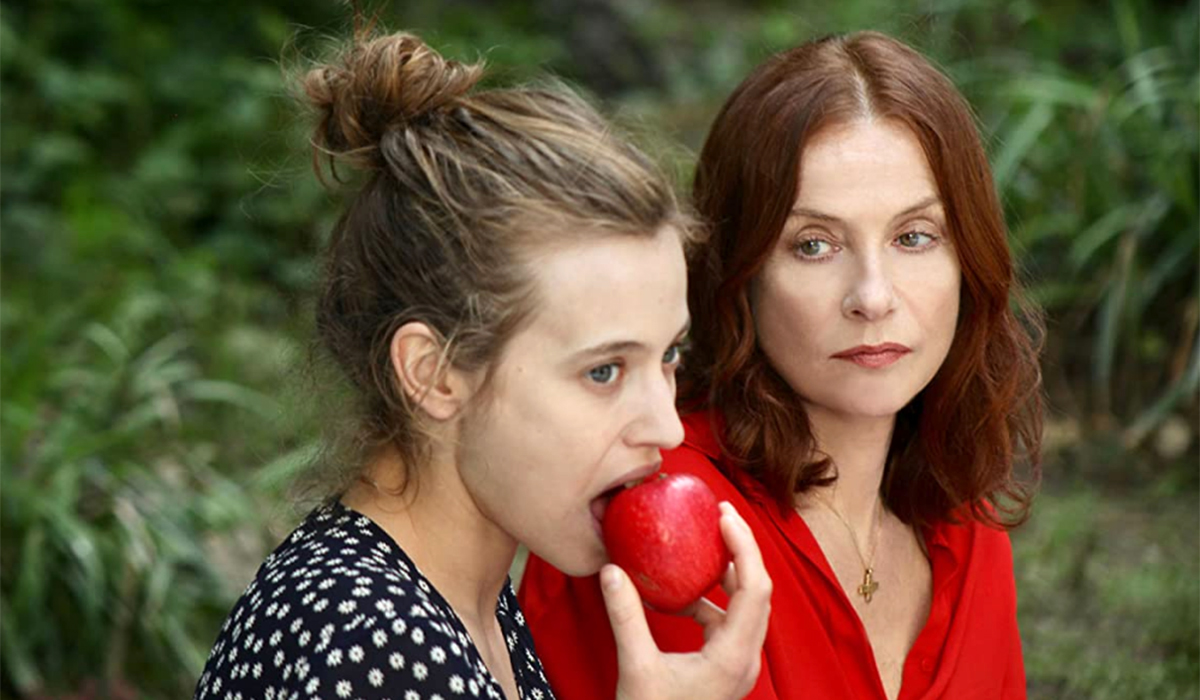A Fairy Tale for Adults

Anne Fontaine’s White as Snow challenges the ‘non-binary’ concept of sex.
Anne Fontaine’s White as Snow (Blanche comme neige) is a surprisingly entertaining modern fable in which a young woman’s sexual conduct reveals our modern moral conflicts. When Claire (Lou DeLaâge), who works at a high-end spa run by her stepmother Maud (Isabelle Huppert), gets kidnapped, her abduction goes awry, leaving her stranded in a provincial village. There, the attention she receives from a number of unprepossessing men arouses passions — liberties — she has repressed.
This setup may sound like a man-hating feminist thesis, but it’s actually an imaginatively updated version of Snow White and the Seven Dwarfs. Fontaine uses the fairy tale’s erotic subtext and political allegory against one’s expectations; its title teases the idea of virginity along with notions about promiscuity, patriarchal judgment, and spiritual purity. Through Claire, Fontaine makes us wonder about standards of individual and social propriety. By fable’s end, Fontaine surpasses the Brothers Grimm to acknowledge French cinema’s romantic legacy. (More on that below.)
French female filmmakers differ from their American counterparts, seeming less defensive, less doctrinaire, and not at all misandrist. Fontaine has defended her approach: “I think that to be a filmmaker, as far as sexuality, it’s something that’s really de-sexualizing. That is, you become a bizarre thing when you’re directing a film — during the shooting, you’re neither a man nor a woman, you’re really something strange and very ambivalent.”
Her narrative twists and aesthetic turns (airy mountain passes, sunlit fields, and dark forests, all vividly stylized by cinematographer Yves Angelo) create a palpable sentience — unlike the insipid 2012 Spanish update Blancanieves by Pablo Berger, but reminiscent of Neil Jordan’s A Company of Wolves (a 1984 adaptation of Angela Carter’s feminist text The Bloody Chamber, which preceded by one year Margaret Atwood’s schematic novel The Handmaid’s Tale). Fontaine shares neo-feminism with Catherine Breillat, who made the startlingly adult version of Bluebeard (2009). Although not as radical as Breillat, Fontaine comes close, endorsing Claire’s promiscuity while acknowledging troubled male appetites.
The seven men captivated by Claire’s presence range from a pair of introverted twin brothers to a classical cellist, a veterinarian, a local priest, and a scholar and his adult son — plus there’s a lesbian barista. Claire intrigues them all. Their lusts, in contrast to Claire’s, attest to tendencies that men and women have in common — their natural, complementary attraction and friction that these days is diminished as “binary.” I realized I was watching something special when, after Claire is told she resembles the models painted by Auguste Renoir, Fontaine observes her character asleep, partially draped by bedcovers, her fleshy torso glowing like a Renoir masterpiece.
In White as Snow, Fontaine concentrates on female anatomy audaciously — nubile DeLaâge seems the spitting image of Barbarella-era Jane Fonda, the comic, sci-fi embodiment of Roger Vadim’s burlesque fantasies. But Fontaine emphasizes female seductive wiliness. Even Huppert’s older, sullen Maud wears a red pantsuit and lipstick that matches Claire’s red waitress uniform — the film’s symbolic colors and vibrant sensuality denote more than a sense of fashion.
Fontaine plays with what academics call “the male gaze.” An ambivalent feminist, she assigns disapproval to Maud, who envies “girls today [getting] into extreme situations.” Huppert’s villain role recalls her title character in Neil Jordan’s Greta (2018), but Maud’s suppressed malice puts one in mind of what a stand-up comedian said about the ladies on The View: “They’re like Disney villainesses.” That turns out to be a fact of their employment, fitting the cartoonish terms of contemporary political opposition. Maud scolds like a vengeful old-time feminist. But beautiful Claire listens to the local priest’s advice: “Christ had a weakness for women of sin.” She asks, “Do you?” He responds, “For the women but not the sin.”
Claire plays vixen games. (“I have passions and am acting them out.”) But is Fontaine playing at the sexploitation satire of Russ Meyer? In her conceit, does she knowingly have the men recall modernist author Donald Barthelme’s 1967 experimental novel Snow White?
As co-written by Fontaine and Pascal Bonitzer, White as Snow also pays homage to François Truffaut’s saga of female mystery, La Sirène du Mississippi (Mississippi Mermaid), in which Catherine Deneuve entices Jean-Paul Belmondo into marrying her. In their getaway cabin, Belmondo discovers a newspaper comic strip “Blanche-Neige et les sept nains” along with a copy of Balzac’s La Peau de chagrin.
These classical references contradict the media’s current non-binary charades. Fontaine honors Truffaut, then goes the master of heterosexual conflict one better when Maud proffers Claire a polished poison apple — and it’s the reddest apple in movie history. Fontaine’s symbolism goes all the way back to Eve. But Claire survives temptation and comes to this intimate realization: “I didn’t know what desire was; now I do. This isn’t fun. It’s life.”





Comments are closed.